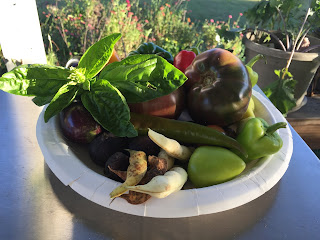End of summer is a great time to tidy garden beds, harvest herbs, and plant for fall and winter harvests. As the days get shorter, growth slows and before long the sun cannot support all the greenery from summer. Plants, trees and bushes will drop leaves, but peppers, tomatoes, eggplant, and cucumbers will keep producing through frost. Keep the fruits picked to keep them producing. Beginning of September is an ideal time to sow seeds of cool weather greens for fall and early winter harvests.
Harvesting Herbs
This is the perfect time to harvest your herbs. You can cut them back so they remain lush, improving the tidiness of your garden, and providing herbs for the winter ahead. Cutting them back will help the plants build stronger root systems. Trimming also encourages new growth. You just don't want to prune too close to frost as new growth makes the plant less hardy.
I dry my herbs to preserve them. I cut the plant back by about two thirds and put the stems loosely in a paper bag in a dry, warm area out of the sun and let dry naturally. Loose is the key here so they get good air circulation and do not mold. They should be completely dry in about 3-4 weeks. I like putting them in clothes closets to dry as they release such great fragrance and the darkness helps keep the flavor in the herb.
Once dried, remove the leaves from woody herbs and store in an airtight container out of direct sunlight. With a soft herb like chives, you can just crumble into the airtight container. I use wide mouth canning jars for herb storage or freezer bags kept in a dark location.
For more ideas on herbs, Use herbs for signature desserts and grown up beverages, Quick tip on fresh flavor herb preservation and herbal butters, Homemade salad dressing recipes with garden herbs, and Make your own teas from garden grown herbs
If the winter is not a bad one, most perennial herbs like chives, oregano, sage, savory and thyme can be harvested year round straight from the garden. If it is a harsh winter, the tops of these perennials will die to the ground, but re-sprout in the spring. .
Fall planting guide for cool season crops
In September, plant more greens, carrots and radishes. October is the month to plant garlic for next year's harvest. Buy your garlic early because the most popular varieties sell out early! I will replant the biggest cloves from this year's harvest. I have both regular garlic and elephant garlic to plant. I like elephant garlic because it produces huge cloves. Time to plant garlic! With growing tips......
You can pick up transplants like broccoli, cabbage, lettuce, kale, as well as herbs at some nurseries since gardening has become so popular. You can also buy them on line or grow from seed. Everything that loves spring also thrive in fall into early winter. Lettuce is my favorite for fall. Plant a variety daily the first two weeks of September so that they are mature by the end of October.
For more on fall planting, Time to set out transplants for fall, winter, & spring harvests
Caring for your new seeds and transplants
Like in the spring, newly sown seeds need moisture to sprout. Keep seeds and transplants moist until they get their first real set of leaves and are well established. Then water as needed. Outdoor seed starting tips
Many crops you can harvest into December and beyond, depending on how cold fall is. Some get sweeter with some frost, like carrots, chard, and lettuce. With cover, you can harvest all the way through winter!
Extend the season with protection for plants
Extend the season with protection for plants
Caring for the Summer Vegetables
Many of the summer veggies will continue producing until the first killing frost. I continue to fertilize the beginning of September and October to keep the plants healthy while they are producing. We are getting less and less daylight now so it is expected that the plants will drop lower leaves and have slower growth. Cucumbers, squash, peppers, eggplants, and tomatoes all keep producing in our garden well into November.
Greens in the garden are getting a second life as the temperatures cool and consistent moisture returns. I tried starting lettuce a couple of times this month with limited success. Lettuce seed will not sprout if soil temperatures are above 75F. I will resow more lettuce and add spinach to the mix as temperatures are forecasted to be lower next week. I'll transplant the seedlings into pots that I keep under the portable greenhouse for the winter to keep salads all winter long.
Greens in the garden are getting a second life as the temperatures cool and consistent moisture returns. I tried starting lettuce a couple of times this month with limited success. Lettuce seed will not sprout if soil temperatures are above 75F. I will resow more lettuce and add spinach to the mix as temperatures are forecasted to be lower next week. I'll transplant the seedlings into pots that I keep under the portable greenhouse for the winter to keep salads all winter long.
A quick reminder, save the seeds from your best performers to plant next year! You can replant seeds from any heirlooms or open pollinated plants. Not only does it save you money, but it also gives you the plants that do the best under your garden and zone conditions. Be sure to save seed only from disease free plants. Seed saving-fun, easy and a cost saver
















